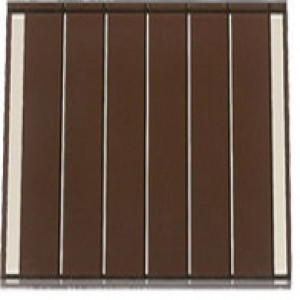| Panasonic Solar Amorton Co., Ltd. |

| Registration Date | 31 Aug 2020 |
| Revision Date | 31 Aug 2020 |
| Share |
Renewable Energies Solar Cells
Solar CellSince multiple cells can be simultaneously connected in a series when the solar cells are formed, unlike the fabrication technique used with crystalline silicon solar cells in which multiple solar cells are severed and connected, it is easy to create cells with a variety of voltages. The methods used in amorphous silicon films have special features that allow other substrates, such as stainless steel or plastic films, to be used instead of customary glass substrates. This means that previously unknown solar cells can also be created, including solar cells that are round, square, or any other complex shape or solar cells that can even be bent. It is also possible to create areas in these solar cells that just consist of transparent glass by etching. The human eye is sensitive to light from a range of about 400 to 700 nm wavelengths. Since amorphous silicon solar cells are sensitive to light with essentially the same wavelengths, they can also be used as visible light sensors.
Solar cells are classified by their material: crystal silicon, amorphous silicon, or compound semiconductor solar cells. Amorphous refers to objects without a definite shape and is defined as a non-crystal material. Unlike crystal silicon in which atomic arrangements are regular, amorphous silicon features irregular atomic arrangements.
As a result, the reciprocal action between photons and silicon atoms occurs more frequently in amorphous silicon than in crystal silicon, allowing more light to be absorbed. Thus, an ultrathin amorphous silicon film less than 1オm (1/1000 of 1 mm) can be produced and used for power generation. Our company is a world leader in developing uWAmortonuW, which is an integrated (series connection structure) amorphous silicon solar cell. Amorton is fabricated by decomposing material gases and forming films on such substrates as glass.
For example, transparent electrode is first formed using a glass substrate. Then three amorphous silicon layers are formed in consecutive layers on the electrode-laden glass substrate: p-type amorphous, i-type amorphous, and n-type amorphous silicon layers. After that, a metal film electrode is created on the n-layer. Finally, it is covered in a protective film, and the solar cell?fs manufacturing is complete.
In this process, many solar cells are separated on the substrate, creating a series connection. This allows any desired voltage to be obtained. Flexible, thin, and durable solar cells can also be produced by utilizing metal or plastic as the substrate.